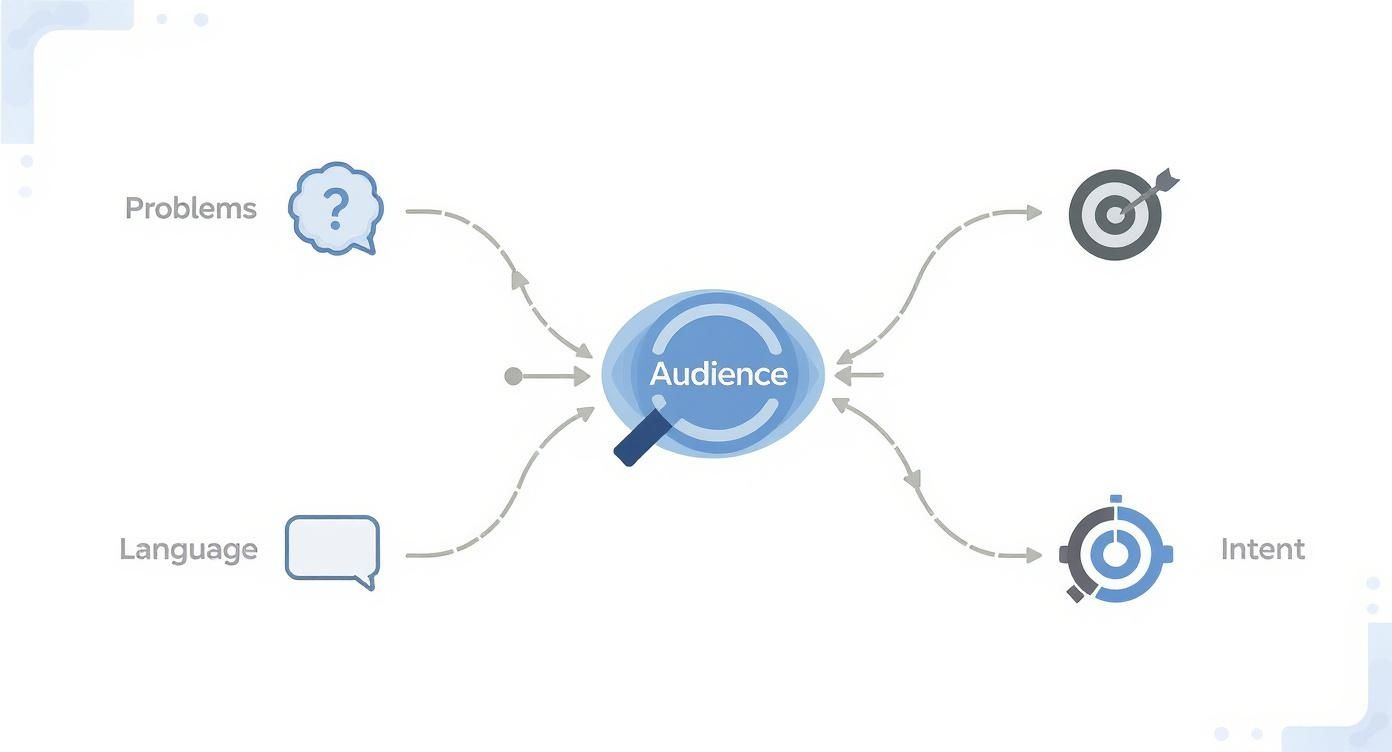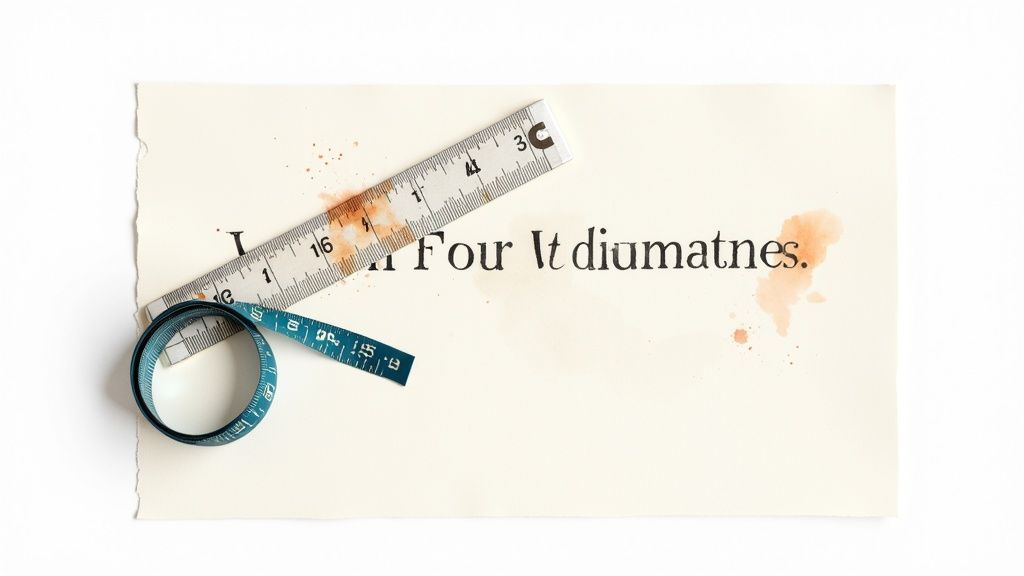Writing a great headline comes down to three things: digging deep into your audience's pain points, leaning on proven psychological formulas, and testing like your business depends on it. It’s less about being clever and more about forging an instant connection that screams, “I have the solution you’ve been looking for.”
Why Great Headlines Are Your Most Valuable Asset

Think of your headline as the gatekeeper to all your hard work. No matter how game-changing your article is, a weak headline guarantees it will gather digital dust. It’s the first—and often only—impression you get to make.
A powerful headline doesn't just earn a click. It sets the stage for the entire reader experience, directly influencing critical metrics like bounce rate and how long people stick around.
This has never been more true than it is today. The global copywriting market is expected to jump from USD 27.96 billion in 2025 to a whopping USD 42.83 billion by 2030. That growth isn't just about writing more content; it's about writing content that converts. Your headline is the very first step in that journey.
The Foundation of Your Content Strategy
Your headline isn’t just some last-minute polish; it’s the cornerstone of your content strategy. It's the promise you make to your reader—and a strong one directly impacts:
- Click-Through Rate (CTR): This is the most obvious one. A great headline grabs attention in crowded search results and social feeds, pulling your ideal reader in.
- Reader Engagement: A headline that accurately reflects the content prepares the reader for what’s to come, making them far less likely to hit the back button.
- Social Shares: Let's be honest, people share content with headlines that make them look informed, witty, or helpful.
Your headline is the first, and sometimes only, impression you make. Without one that stops the scroll, the rest of your words might as well not exist.
Getting headlines right is fundamental to making sure your message actually lands. To see how they fit into the bigger picture, check out these B2B content marketing best practices.
For even more ideas on building a content engine that actually moves the needle, have a look through the https://rebelgrowth.com/blog.
Connect with Your Audience Before You Write
An irresistible headline starts with deep empathy, not a clever template. Before you even think about formulas or word choice, you need to understand who you're writing for—and on a much deeper level than simple demographics.
The best headlines speak directly to a reader’s secret problems and aspirations. They feel less like a pitch and more like a solution they’ve been searching for.
Forget guessing what your audience wants. The most powerful insights come from observing them in their natural habitats. Spend time lurking in forums where your audience gathers, like specific subreddits or Quora topics. Notice the exact words and phrases they use to describe their frustrations and goals. This is your raw material.
What you're looking for are unfiltered pain points. Pay close attention to questions that appear over and over again, and zero in on the emotional language they use.
Create a Simple Audience Snapshot
You don't need some exhaustive 20-page document to do this effectively. In fact, a crucial step in connecting with your audience is simply defining who they are. You can use techniques like creating buyer personas for Google Ads to gain deeper insights. The whole idea is to move from an abstract "target market" to a tangible person you can write for.
Your goal is to build a simple but vivid picture of your ideal reader. A useful snapshot includes just three things:
- Their Biggest Problem: What is the one major hurdle they are trying to overcome right now?
- Their Desired Outcome: If they could wave a magic wand, what would their ideal solution look like?
- Their Secret Language: What slang, jargon, or specific phrases do they use that an outsider wouldn't?
For instance, a marketer targeting early-stage entrepreneurs might find their audience isn't searching for "customer acquisition strategies." Instead, they're on Reddit asking, "How do I get my first 10 customers without a budget?" That language difference is everything.
When you know your reader’s exact pain points and speak their language, your headline stops being an advertisement and starts feeling like a solution they've been searching for.
This research isn't a one-time task; it's an ongoing practice. The more you immerse yourself in your audience's world, the more intuitive it becomes to write headlines that just work. You stop writing for them and start writing to them.
Headline Formulas That Consistently Perform
Relying on proven headline formulas isn't cheating; it's just smart marketing. Think of them as shortcuts that tap directly into the psychological triggers that make people want to click. These structures have been battle-tested for years because they speak directly to a reader's needs, fears, or curiosities. You don't need a hundred different options—just a handful of reliable ones you can tweak for any situation.
A good starting point is to get inside your reader's head. What problem are they trying to solve? What words do they use to describe it? And what are they really trying to accomplish? Nail these, and any formula you use will be ten times more effective.

This visual really drives home how a reader's problems, language, and search intent are all connected. Once you get a feel for these three pillars, applying the right headline formula becomes second nature.
The Power of Specificity and Numbers
Headlines with numbers almost always perform well, and for a simple reason: they make a concrete promise. A number tells the reader exactly what they're getting into, both in format and depth. You've probably heard that odd numbers outperform even ones—and some studies show a slight edge—but the real magic is just in the specificity itself.
For example, a headline like "How to Improve Your SEO" is just too vague. It floats in a sea of sameness. But "7 Actionable Ways to Improve Your SEO in 30 Days"? That's a completely different story. It sets crystal-clear expectations and hints at a tangible, time-bound result.
The most effective headlines make a specific promise that aligns perfectly with a reader's goal. They don't just offer information; they offer a clear, structured solution.
This kind of specificity is also a non-negotiable for things like high-converting landing pages, where the headline has about three seconds to communicate value before a visitor clicks away.
To give you a better idea of how these formulas work, here’s a quick breakdown of some of the most reliable ones I've used over the years.
Headline Formula Breakdown
| Formula Type | Core Concept | Example |
|---|---|---|
| Numbered List | Makes a concrete promise of scannable, digestible content. | "9 Cold Email Templates That Actually Get a Response" |
| How-To | Directly addresses a user's problem and offers a solution. | "How to Set Up Google Analytics 4 in Under 15 Minutes" |
| Question | Sparks curiosity and creates an "information gap" the reader wants to fill. | "Are You Making These 5 Common Landing Page Mistakes?" |
| Benefit-Driven | Focuses on the positive outcome or result the reader will achieve. | "Write Headlines That Get 50% More Clicks in Half the Time" |
| Negative / Fear | Taps into the reader's fear of loss or making a mistake. | "Don't Launch Your Ad Campaign Until You Fix This" |
| Social Proof | Uses credibility or testimonials to build trust and authority. | "The SEO Strategy That Helped Us Grow Traffic by 188%" |
Each of these formulas taps into a slightly different psychological trigger, but they all share one common trait: they make the content feel more relevant and urgent to the right person.
How To and Question Headlines
The "How-To" headline is a timeless classic. Why? Because it's a direct signal to anyone looking for a solution. When someone is actively trying to solve a problem, a "How-To" title promises actionable steps. The trick to making these really pop is to add a powerful benefit.
- Good: "How to Write Headlines"
- Great: "How to Write Headlines That Get 50% More Clicks"
See the difference? The second one isn't just about the what, it's about the why.
Question-based headlines work a little differently. They engage the reader's mind by creating an "information gap" they feel an itch to scratch. A question makes someone pause and think, which is half the battle.
Something like, "Are You Making These Common Content Mistakes?" immediately puts the reader in the driver's seat. It forces them to wonder, "Wait, am I?" which drives them to click and find out. The very best question headlines hint at a problem the reader might not even know they have, creating an instant sense of urgency.
Refining Your Headlines for Maximum Impact

Coming up with a great headline idea is only half the battle. To really make it pop, you have to structure that idea for performance. This is where you shift gears from creative brainstorming to the nitty-gritty details that turn a good headline into a traffic-driving machine.
The best headlines aren't just clever; they're polished and intentional. They have to walk a fine line, grabbing human attention while also ticking the right boxes for search engine algorithms. You'd be surprised how much small tweaks to length, punctuation, and clarity can move the needle on your click-through rates.
Find the Sweet Spot for Headline Length
Length is one of the easiest—and most impactful—elements to get right. If your headline is too long, it gets cut off in search results. Too short, and it might not have enough meat to convince someone to click. The goal is to be concise yet compelling.
After analyzing tons of data, we know that headlines with 6 to 13 words consistently pull in the most traffic. If you want to get even more specific, titles between 6 and 8 words long can give you a click-through rate boost of up to 21%. Staying in this range keeps your headlines punchy and, just as importantly, fully visible on the results page. You can dig into more of these blogging statistics from OptinMonster if you're curious.
This isn't just a technicality to avoid getting truncated. It's about psychology. A headline in that sweet spot feels substantial enough to be valuable but is short enough to be digested in a single glance.
Use Punctuation and Numbers Strategically
Simple punctuation can be a surprisingly powerful tool for making your headline stand out. Adding a hyphen or a pair of brackets can break up the visual pattern of search results, drawing a reader's eye right to your link.
Don't underestimate the small details. A single pair of brackets or a well-placed number can be the deciding factor that earns you the click over a competitor.
Think about adding these tactical elements to your toolkit:
- Brackets [ ]: These are perfect for calling out a bonus or clarifying the format. Think
[Free Template]or[Video]. It sets clear expectations and immediately highlights extra value. - Hyphens -: A hyphen is fantastic for creating a subtitle effect. It lets you add a compelling benefit right after your main title, like, "How to Write Headlines - A Beginner's Guide."
- Numbers: Like we've touched on, specific numbers build instant credibility and make a concrete promise to the reader. "7 Ways to..." is just so much more compelling than "Ways to..." because it tells people exactly what they're going to get.
These simple refinements are what elevate a basic idea into a polished, high-performing asset.
How to Test Your Headlines with Real Data
The most successful writers I know don't rely on guesswork. They have a system, and they let their audience's actions guide their decisions. Building a simple process to test your headlines is probably the single best way to give every article its greatest chance of success.
This whole process is about removing subjectivity and replacing it with cold, hard data.
The easiest way to get started is with A/B testing, which you might also hear called split testing. A lot of email marketing platforms and ad managers have this functionality built right in. You can just plug in two different headlines and let the software show each one to a different slice of your audience.
Interpreting the Results
The main number you'll want to keep an eye on is the click-through rate (CTR). This metric tells you exactly what percentage of people who saw a headline were compelled enough to actually click it. A higher CTR is your clearest signal of a winning headline. It's that simple.
Large-scale experiments back this up. For instance, The Washington Post did extensive testing across nearly 20,000 headlines and found that simpler language consistently boosted reader engagement. You can read the full research about these headline findings if you want to go deeper into the data.
Don’t just write one headline—write several and let your audience tell you which one works best. Data always beats intuition.
This continuous feedback loop is what separates good content from truly great content. For a deeper dive into optimizing your strategy, our AI SEO checklist provides actionable steps to refine your entire process.
Common Headline Writing Questions
Even after you get the hang of the formulas and tactics, a few questions always seem to come up. Let's dig into some of the most common hurdles writers hit when they're trying to nail their headlines.
I want to give you some clear, no-fluff advice for those moments when you're feeling stuck.
Strong Headline vs. Clickbait
This is the big one. Everyone wants to know where the line is.
A strong headline makes a specific promise and then actually delivers on it. Think of it as building trust. You're accurately telling the reader what value they'll find inside the article. For example, "7 Ways to Reduce Customer Churn by 15%" sets a clear, specific expectation.
Clickbait is the opposite. It makes some wild, over-the-top, or even misleading promise it has no intention of keeping. It's all about emotional tricks or leaving out crucial details to get that click. You've seen them: "This One Simple Trick Will Change Your Business Forever!" Just stick to making honest, valuable promises, and you'll be fine.
Writing for Niche B2B Audiences
When you're writing for a super-specialized B2B crowd, you have to switch gears. Forget the broad, catchy stuff that works for a general audience. Your goal is to use language that signals you're an insider who gets their specific problems.
Sprinkle in the industry terms and acronyms they use every day. You're not trying to get everyone to click; you're trying to get the right people to click. A headline like "Optimizing Your CI/CD Pipeline for Kubernetes Deployments" will grab a DevOps engineer's attention in a way a generic title never could.
For niche audiences, clarity and relevance always beat cleverness. Your headline should act as a filter, attracting qualified readers while deterring those who aren't a good fit.
How Many Headline Variations to Create
There isn't a magic number here, but a solid rule of thumb is to draft between 5 and 10 variations for every single article. I know it sounds like a lot, but this one habit forces you to move past your first idea, which is almost never the best one.
Play around with a few different formulas to see what sticks:
- Try a classic numbered list.
- Frame one as a question.
- Write a version that focuses purely on the benefit.
- Craft a direct, no-nonsense "how-to" headline.
Going through this process helps you look at the topic from different angles. More often than not, you'll uncover a much stronger, more compelling headline than the one you started with.
At rebelgrowth, we help you build a content engine that drives real results, from crafting irresistible headlines to scaling your entire marketing strategy. Learn more at rebelgrowth.com.
